For more information:
Note that the latest stuff may not yet be indexed.
The Klezmer Shack directory of articles
The Soul of Klezmer, 30 Dec 2001
The Soul of Klezmer, 1998
San Francisco Klezmer Experience / Zing!, 1998
Channe Nussbaum & Spielniks / Jidishe Mame, 1998
Jack Kessler / Kol Yaakov, 2001
Bang on a Can / Renegade Heaven, 2000
Abby Rabinowitz / We used to dance, 2000
Klezmerica / Jerusalem of Blue, 2001
Musa Berlin / Aneinu
v'yom koreinu (Answer us on the day we call), 2001
Di Gojim / "Ergens..." (Somewhere), 2001
Jamie Saft / Sovlanut, 2000
Jeremy Brown / This year in St. Louis, 2001
This is the season when the flow of wonderful new CDs is balanced only by my attempt to make sure that some old ones don't further escape notice. This has been an excellent week to listen to the music about which I am supposed to be writing. And it's the last chance I'll have to post some reviews in this secular year, 2001. Enjoy.
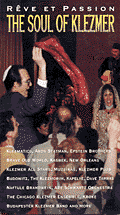 The Soul of Klezmer, 1998 (Wergo SM 1506-2).
The Soul of Klezmer, 1998 (Wergo SM 1506-2).
A great collection of klezmer music should include a diversity of music from different times and places, great liner notes, and should even be sure to include a few songs that will be unfamiliar even to most people who listen to klezmer. This double-CD compilation, from Network three years ago, meets all of those criteria. In addition, the liner notes appear in German, French, and English. They do a fair job of describing klezmer and some popular Yiddish music, and present tunes from bands as diverse as the Klezmatics, Dave Tarras, the New Orleans Klezmer Allstars, Budowitz, Kroke, Sam Musiker, the Epstein Brothers (with singer Ava Gold), and even Muszikás. If I were trying to present something to a friend who was unfamiliar with the genre, this is a collection that I would happily give. Other sets in the series (as of 1998) were North African Music ("Desert Blues"), music of the Rom ("Road of the Gypsies"), Sufi tunes and an homage to Nusrat Fateh Ali Khan. [GRADE: A]
 San Francisco Klezmer Experience / Zing!, 1998 (Krywanoga KRY 002) www.davkamusic.com/sfke/".
San Francisco Klezmer Experience / Zing!, 1998 (Krywanoga KRY 002) www.davkamusic.com/sfke/".
The San Francisco Klezmer Experience was put together by Davka violinist Daniel Hoffman to play music for the musical, "Shlemiel the First," in San Francisco. With members who have been playing klezmer since touring with the Klezmorim (usually credited as the first band of the Klezmer Revival), the SFKE shows strong evidence of carrying on the Klezmorim's frontal wall-of-sound-and-energy approach, including some lovely pure jazz interruptions (in addition to the obvious break in "Hash," and numous other places, I really love the relaxed "Dem Ganefs Yikhes"). This band also adds the memorably delightful voice of Jeanette Lewicki and a forceful connection to davening with Steven Saxe's (am I picking on the right vocalist?) "Hineni", from the Yom Kippur services. If there is a bone to pick, it is with this reviewer to be more than two years late in giving this album its due. Before I end, I also want to call attention to the Flying Bulgars-inspired "Hash", Stuart Brotman's (also of Brave Old World, among dozens of other bands going back to the Sixties) tsimbl playing. In recent years, the tsimbl has become a popular sound effect to music poorly played. Here, as in Brave Old World, and a handful of other great bands, it is part of the music. I also note a lovely album cover and meticulous (and best-for-readers-layout) of Yiddish/Hebrew and English in the liner notes. [GRADE: A-]
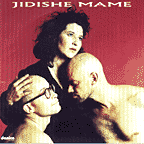 Channe Nussbaum & Spielniks / Jidishe Mame, 1998 (Danica DCD 8199).
Channe Nussbaum & Spielniks / Jidishe Mame, 1998 (Danica DCD 8199).
The first release by the Spielniks with Nussbaum (Copenhagen Klezmer) was a very tasty blend of something that was not particularly klezmer, but still lots of fun. This newer release, however, pushes Yiddish music further into a new direction, "JidPop" (Americans, use a Dutch "J"--our "Y" sound), which involves Yiddish music set to a more rocking, if still Yiddish-inflected beat, and involves one of the sexiest voices (and most suggestion album covers) in recent memory. Indeed, Nussbaum has become known as something of a Yiddish sexual symbol in Europe--an unusual goal, and an unusual success. (A glance at the cover for this album may illustrate why my mind has a hard time letting loose of an early 1970s album by a band called Ramatam, "In April came the dawning". This album is far, far better.) The thing is, though, that this is a delightful album, and the music makes for great listening. It has far less to do with anything traditionally Jewish than with general EuroPop. But, the suggestion in Nussbaum's voice on songs such as "Schwartse nacht", is appealingly sexy. The song, itself, is pure pop with lyrics that have a vaguely Jewish connection. So what? This is not an album for those who are looking for the latest Yiddish folk release, or even for those seeking new Yiddish music. Well, but that's the thing. But, in its own way, this is new Yiddish music, even if that way is possibly offensive to an earlier generation and even to my peers involved with the Yiddish revival. Songs such as "Jidishe Mame" which are closer to tradition aren't my mother's "Jidishe Mame", but it's the first time I've enjoyed listening to "Papirosn" since I first heard it. The cowboy guitar and bass lines behind "Elsbein polka" or "Joshke fort avek" demonstrates how far things are going, and how good that can sound. You won't feel the same way about "Ganze Mishpoche" ever again. This album may be far out there in terms of, well, tradition. But, this is great stuff. I hope they've kept recording since this was released! Major fun. [GRADE: A]
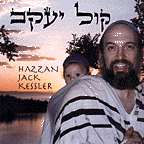 Jack Kessler / Kol Yaakov, 2001 (JK2669).
Jack Kessler / Kol Yaakov, 2001 (JK2669).
Kessler's two ensembles, Atzilut and Klingon Klezmer define two interesting endpoints of popular Jewish music. Here, he tends more towards the spiritual side previously supported by his ensemble Atzilut. Backed by a sparse ensemble and occasional backing vocals and duets with Marcia Prager, he performs a familiar-sounding, but also renewed nusach for the Sabbath and other Jewish holy times. Kessler's voice is rich and deep, and well-suited to davening and nign (although he sounds as though he would be equally at home, and equally pleasurable singing more traditionally-arranged nusach). At its best, the music is haunting and lovely and filling. Occasionally, there is too much repetition of the same phrase over and over--a groove band's sameness of sameness. Such repetition is sometimes good for actual t'filah or meditation, but less comfortable when one is attentively listening. Nonetheless, the is one of the rare albums this year (along with Shirona's) to address prayer in a way worth listening, and this is well-worth listening. [GRADE: A-]
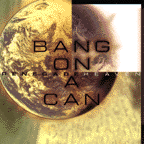 Bang on a Can / Renegade Heaven, 2000 (cantaloupe CA21001) www.bangonacan.com.
Bang on a Can / Renegade Heaven, 2000 (cantaloupe CA21001) www.bangonacan.com.
Some day someone will explain why listening to driven explorations of sound and repetitive phrasings is so relaxing to me, when done with this rare grace and passion. But from the opening urgency of Julia Wolfe's "Believing," I found myself a believer, and I sink into explorations and textures of sound and rhythm that just feel right, without doing that new age meandering thing that drives me over the edge. This is simply excellent avant garde music, and one of the first excellent such albums I've found since, say, the last edgy Anthony Coleman project I picked up. This is rhythmic in the way that parts of Coleman's "Disco by Night" are rhythmic, in a similar, post-classical string ensemble sort of way -- like Kronos Quartet at their best (although I haven't found Kronos' recent work to be particularly experimental), and despite the presence of keyboards, electric guitar, clarinet and percussion. There is even one quieter meander, the closing "Exquisite corpses", but even here, there are interesting layers of sound and some lovely biting clarinet. This album is also one of the rare times when I find myself actually enjoying the percussion, rather than wishing it would thumpa thumpa somewhere else. (This is not thumpa thumpa percussion.) Featured on numbers such as "Escalator" it manages to be present and to provide form without distracting. And then it's out of the way on more spacy numbers such as the long, slip-sliding, "Movement within". [GRADE: A]
 Abby Rabinowitz / We used to dance, 2000. Yamnua Records, YR7425-CD, www.flutestory.com
Abby Rabinowitz / We used to dance, 2000. Yamnua Records, YR7425-CD, www.flutestory.com
The album is such a pleasure! Klezmer Conservatory Band flautist Abby Rabinowitz, the answer to the question, "klezmer? on flute?" here records a host of songs, klezmer-derived or otherwise, classically- and jazz- influenced, and reminds us that, while klezmer is to dance, there is dance beyond klezmer. Although the opening "Conor rides the trains" is very much a klezmer piece, the following "Runaway Freylekhs" are much more in other traditions, and mostly an excuse to show how joyous a flute can sound. Backed by members and alumni of the KCB, including Mimi Rabson on violin, Evan Harlan on accordion, Jim Guttman on bass, and Grant Smith on drums, the ensemble make it sound like this is a busman's holiday that actually is a holiday. The jazzy interplay between Harlan, Guttman, and Rabinowitz on "The Spirit Moves," for instance, is the kind of quiet pick-me-up that everyone needs for a snow day (today, in Boston, for instance). Even a quiet, gentle, "Indian Caravan" can't keep that energy and pleasure in making music from being apparent. In fact, beyond genre, if there is anything that typifies this album it is that luminous joy that makes it the perfect pick-me-up for any day, gray or otherwise. Thank you! [GRADE: A+]
 Klezmerica / Jerusalem of Blue, 2001, www.klezmerica.com
Klezmerica / Jerusalem of Blue, 2001, www.klezmerica.com
Once upon a time there was a rather good klezmer band based in Minneapolis that played rather good music and made jokes about the "Frozen Chosen". They moved more and more into jazz, eventually releasing an album of politely klezmerized Gershwin. But, somewhere in the stew of very good klezmer and very good jazz, they seem to feel that they are in a new country which they call (and after which, they have renamed their band) "Klezmerica." I have to admit that they may have a point. This is excellently played klezmer, but only klezmer as it could be played in America, with a healthy dose of jazz behind the krechts. In many of the best ways, this recording exemplifies the type of mainstream klezmer many of us Jewish-Americans would like played at our weddings, music that reflects both the Americanized (but still, to us, very Eastern European Jewish) klezmer, and straightforward, well-played, American Jazz. Unlike most crossovers, Klezmerica has managed to do this without losing the soul of the music. It can be a conflict, as one hears in the competing lines and flavors of "Vulgar Bulgar" which can't decide whether or not to be klezmer music or classically-influenced jazz, or it can be completely jazz, as in "A Morning in Tsfat". At times, the band reminds me of the Jewish-Jazz Dutch fusion band, Klezmokum, but here there is a much stronger expression of the klezmer side of things. Still, to keep that strong, and to synthesize all these musics well, that is ultimately, very good. [GRADE: A]
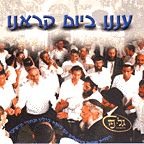 Musa Berlin / Aneinu
v'yom koreinu (Answer us on the day we call), 2001, Gal-Paz, Israel, in the US, Tara Music. Double CD.
Musa Berlin / Aneinu
v'yom koreinu (Answer us on the day we call), 2001, Gal-Paz, Israel, in the US, Tara Music. Double CD.
It opens up with Musa's clarinet wailing as the crowd sings, lost in ecstasy. Periodically, the guitar slides in a short solo. This is one of those legendary live recordings where the spiritual meets the klezmer, a sort of grounding of what klezmer music sounds like--and what the celebrants sound like--when you have tapped into the source. Berlin considers this album one of his "Carlebach" albums in which he is interpreting not only the songs of the Meron tradition for which he is renowned in Israel and abroad, but here plays many songs from the Carlebach song book. The recording was done nine years ago by Joel Rubin and Rita Ottens of Berlin and his ensemble at the
second Hakafot after Simchat Torah in the Beit ha-Rav Kook Yeshiva in
Jerusalem. According to Rubin, there were 4.5 hours of tape, from which he and Ottens released a set (slightly longer than the Gal Paz release) in their Wergo Series in 2008. The Wergo recording has also extensive liner notes (none here), and the Hebrew texts are available from a link on Rubin's website. Musa, himself, has stories of people listening to the music and being moved to tears. There is such an amazing energy to this album, and an incredible "noise level" of excited celebrating Yeshivish voices! If you want sonic clarity, then Berlin's Sulam recording, also live, would be a better choice. But, after listening to this repeatedly, I can only say that I understand, I hear, am moved. [GRADE: A]
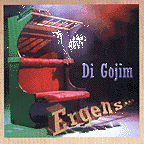 Di Gojim / "Ergens..." (Somewhere), 2001, Syncoop 5761 CD 254, www.syncoop.com.
Di Gojim / "Ergens..." (Somewhere), 2001, Syncoop 5761 CD 254, www.syncoop.com.
Years ago I wrote about how this Dutch band, di Goyim, made this amazing klezmer music. It's still true, although in this latest offering, the brassy, wonderful, American klezmer reimported to Europe is mixed in with other brass traditions, and a selection of folk songs sung in a decidedly non-Eastern European Yiddish manner. Until I was enlightened by a band member, I was sure that the album contained a mix of Dutch folk and klezmer. According to the band, most of the material was found on old LPs from Rumania, with sources ranging from Zamfir and the wonderful gypsy brass band, Fanfare Ciaocarla, to klezmer. Yet, surely the opening male folk chorus accompanied by accordion holds more to general European folk ensemble sensibilities than to Jewish, or to Romanian singing tradition. When the band fills in for a full-klezmer thrust, the brassy enthusiasm and skill are far closer to early 20th century American klezmer tradition than to post-revival European sensibilities. On the other hand, their "Buitensporige Drieluik" (The Outrageous Three), also owes more to American Klezmer Revival than to this form of brass music as played in the Balkans and Romania. On "Lied van de verloren Liefdes" (Song of the lost love), one even gets hints of Blind Willie McTell's "Dying Crapshooters Blues." That doesn't necessarily matter. The poignancy, of "Oorlog en Vrede" (War and Peace), a Greek song, "El Fajum" by Jakis Jordanopoulos, to which they have added Macedonian and Rumanian tunes is present and powerful, and the tuba-inflected march chorus that comes towards the end, no less triumphant. Clearly, the band is on the move and incorporating more types of music than when I last listened. What hasn't changed, however, is the skill and enthusiasm with which the band turns its sources into listenable, danceable, and enjoyable music. As primary exemplars of the music into which klezmer and related folk traditions have been transformed, these outsiders still excel at taking us "Ergens", somewhere, special. [GRADE: A]
 Jamie Saft / Sovlanut (Patience), 2000
Jamie Saft / Sovlanut (Patience), 2000
A few years ago New York's Jewish Museum put on an exhibit of Jewish artists riffing on Jewish issues. Called "Too Jewish?" the exhibit celebrated Jewish American artists working decisively with Jewish themes, and represented a significant step from the spirit of a previous generation where artists like Rothko or Koonst were Jewish, but whose art was seen (by both artist and public) as American, rather than Jewish. It is most appropriate, then, that Jamie Saft's first Tzadik recording, "Sovlanut" (Hebrew for "Patience") features an Andy Warhol-inspired Manishevitz matzo box by Adam Rolston--one of the featured pieces of art from "Too Jewish?". Indeed. Opening with "Kasha Dub"--a brief distorted guitar that fades into a lovely dub beat, dubbed over traditional Jewish prayer, the album is very much in tune with that exhibit, and indeed, the entire sensibility of fusing the traditional Jewish religion and culture with which many of us were raised into something that is both American, and a new sense of what "Jewish" means in this generation. This is not the time or place to expound on the connections between this album and, say, work by Anthony Coleman's Self-Haters, Hasidic New Wave, Gary Lucas' equally accessible riffs on the same culture, or even Benjamin Laden's "Benny and the Vildachayas."
But music this interesting, tying Jewish prayer to inviting, deep fusions with popular American music sources, exemplifies what the Tzadik label does best: present Radical Jewish music. Although a "dub jam" atmosphere suffuses the album, the music is far more complex and varied, ranging from the general jazz fusion explorations of "Tefachim," a lá Miles Davis of "Bitches Brew" vintage) to the synthesized weight of massed middle eastern violins and improvisation with oud and guitar ("Mach/Hey"), to free-ranging computer-mangled guitar sound as rhythm ("Midwood Cowboy"), to a ska-tinged dub end. Interestingly, the direct Jewish content throughout the album comes from one voice chanting a Haftorah portion (the selection from Prophets chanted on Saturdays after the Torah readings), making this less a statement of general Jewish redefinition, and more one of redefining the act of Jewish prayer. The terse liner notes imply a more general set of Jewish influences ranging from Dylan to the Passover seder. This is the sort of album that rewards careful listening with considerable depth and humor, while still being great for just ... listening! [GRADE: A]
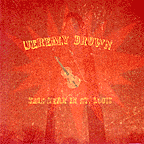 Jeremy Brown / This year in St. Louis, 2001. E-mail Jeremy Brown
Jeremy Brown / This year in St. Louis, 2001. E-mail Jeremy Brown
Brown, plays in several bands in St. Louis (including one "traditional" klezmer band, and one, "treif" that isn't so traditional). Here, he has an opportunity to showcase his considerable fiddle and mandolin skills across a wide range of musical styles ranging from the opening cowboyish "Downhill" (cowboyish--bluegrass with too much thumpa thumpa drums), to the more successfully bluegrassy fiddle, guitar, and mandolin excursions on "Possum Way" and on into klezmer. Indeed, on those parts of the album where the percussion is further back in the mix I am delighted and enchanted; this album, overall, is a perfect example of how a prominent beat can distract from the flow of elegant and exciting music, and then be finally overshadowed simply by the merits of those same elegant and flowing, intricate and varied melodic lines. Sometimes. It isn't just a matter of volume. The high-energy "Fruitvale Freilach Melody" swings delightfully, despite an overloud and undervaried thumpa thumpa accompaniment. The preceding, delicious, "Bride's Hora" is so constrained by overemphasis on each beat that it feels as though the piece has been imprisoned by a metronome. And then, one of the album's highlights, "Isaac's March," with its slightly irregular drum rolls, seemed such a perfect combination of elegy and hope that Judy Pinnolis, of the Jewish Music WebCenter, used it to represent her site's memorial to 9/11. All in all, a very interesting and excellently diverse album. [GRADE: A-]

